
Viz Mosart User Guide
Version 5.0 | Published June 21, 2022 ©
Control Command Keys
This section focuses on control commands and the common use case of assigning them to a keyboard shortcut. Topics covered include:
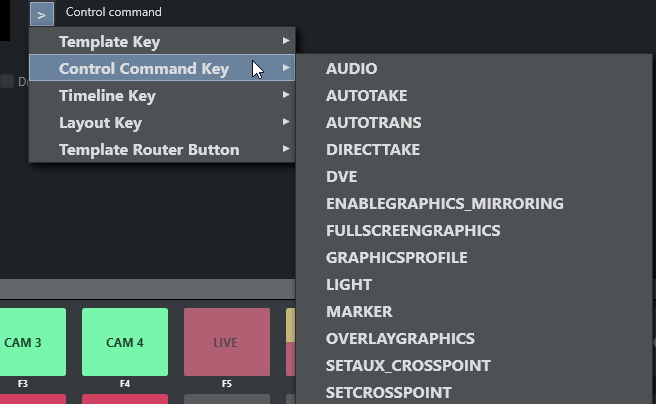
Control Commands are commands the operator can send directly to one of the connected devices, independent of templates currently in use.
For example, a control command key can be defined to send a DVE FORWARD command to the vision mixer or similarly, a Continue graphics command can be sent to the connected graphics system.
Most of Control Commands have parameters attached to them, as described below:
Keyboard-based Control Commands
Common Parameters
Touch Mode
![]()
All control command keys share the TouchMode parameter.
-
OnAir indicates that clicking or pressing the keyboard shortcut in the shortcut window immediately executes the relevant control command.
-
None disables touch/click functionality for the button.
Adding a New Command
-
From the menu bar select Tools > Keyboard shortcuts editor.
-
Click Add new command to add multiple commands to a shortcut.
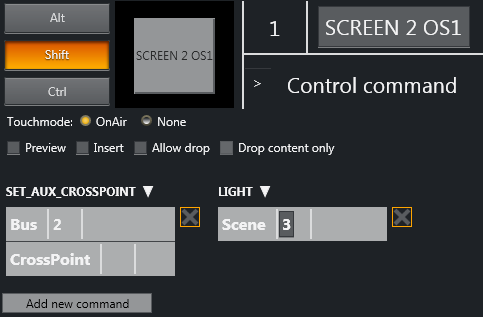
In the figure above, two commands have been added: SET_AUX_CROSSPOINT and LIGHT.
These commands are executed sequentially from left to right (in the example, first SET_AUX_CROSSPOINT, then LIGHT).
AUDIO
Audio Control Commands have an associated Faderate parameter, which allows the operator to set a fade rate in frames where relevant.

Audio Parameters
|
Name |
Description |
|
FADE_OUT_KEEPS |
Faders that are set as "keep level" in the template On Air are faded out. Default: CTRL+F Will also work when new templates have been taken in between the 'keep' action and the FADE_OUT_KEEPS. |
|
FADE_MANUAL |
The audio faders for the On Air server channel are set to Manual control, and are not changed by Viz Mosart until taken out of manual control again. Default: CTRL+M |
|
FADE_UP_SECONDARY_AUDIO |
Viz Mosart fades up relevant audio sources not connected to the video currently On Air, when cutting between sources. |
|
FADE_DOWN_SECONDARY_AUDIO |
Viz Mosart fades down relevant audio sources not connected to the video currently On Air. Default: SHIFT+F10 |
|
FREEZE_AUDIO |
With the Control Command Freeze Audio all sound faders are frozen, and do not respond to commands from templates. |
|
SET_LEVEL_2_PREVIEW |
The second level for faders in the template are set on the template which is in preview, and be performed on next transition. Default: CTRL+L |
|
SET_LEVEL_2_ONAIR |
The second level for faders in the template which are On Air are set. Default: SHIFT+CTRL+L |
AUTOTAKE
Sets the Viz Mosart system to auto take mode.
PARAMETERS: The key can be defined as a toggle key, or two separate keys can be used to activate or deactivate autotake mode.
Default: Toggle with CTRL+SHIFT+A.
AUTOTRANS
Tells the switcher to perform a transition on a given ME between the currently cued and On Air source.
PARAMETERS: ME and transition rate.
DIRECTTAKE
Executes a direct take template.
PARAMETERS: Recall Number of the direct take template.
You can create a direct take in the Template Editor. Note that all direct takes have to be created as part of the special Directtakes template set. Under Template properties (Recall Nr) the direct take number is defined. When the direct take has been created, you can assign a keyboard shortcut to perform this direct take, under 'Control Command Key' in the Keyboard Shortcuts editor.
DVE
Sends a forward or reverse command to the DVE in the vision mixer.
PARAMETERS: Set to forward or backward.
Default: Forward with PageUp
Default: Backward with PageDown
ENABLE_GRAPHICS_MIRRORING
Target: FULLSCREEN, OVERLAY, ALL - Where to enable/disable graphics mirroring
Action: ENABLE, DISABLE - What to do
This is for the functionality of sending same graphic commands to multiple graphics engines.
FULLSCREEN_GRAPHICS
ENGINE: The engine number on which control commands execute. The engine number is selected from the drop down menu and must be same as the number defined in AV Automation.
Action:
-
CONTINUE: Send a continue command for a fullscreen graphic on a graphics engine.
-
MACRO: For graphics systems that support macro recall, this recalls a macro on the defined engine.
PARAMETER: The Parameter value has specific functionality depending on the chosen command.
When MACRO: Name of the macro to recall.
For VIZRT graphics, two special macros are available: "INITIALIZE" (or "INITIALISE") and "CLEANUP", which initializes and clears the playlist, respectively.
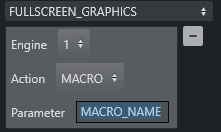
Default: Send a Continue to the current engine with F11.
GRAPHICSPROFILE
Changes the current graphics profile loaded.
PARAMETERS: Enter the name of the desired graphics profile.
LIGHT
Activates a specific light setup.
PARAMETERS: Enter the number of the desired scene
MARKER
Inserts a metadata marker into the timeline.
PARAMETERS: Description to be entered for the marker.
OVERLAY_GRAPHICS
The Overlay Graphics Interface provides control and monitoring of overlay graphics for all Viz Mosart-approved graphic engines. For a detailed description, see section Overlay Graphics Interface of the Viz Mosart Administrator Guide.
All Overlay Graphics commands share the Render parameter. This parameter can be set to send the given command to a specific engine, or to engines which currently have active graphics On Air.
In addition, the Parameter value has varying functionality depending on the chosen command.
-
CLEAR: This command takes out all on-air overlay graphics. Default: CTRL + X.
-
Parameter specifies the destination to clear the graphics from.
-
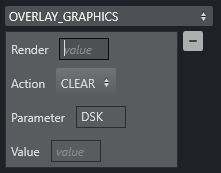
-
Render specifies the engine number (from the Overlay Graphics screen) to clear the graphics from if Parameter is empty.
This value can also be non-numeric (in the left-hand example below: Current), to clear the graphics from all the engines.Any non-numeric value (including the empty value) has the same effect: Clear the graphics from all the engines.
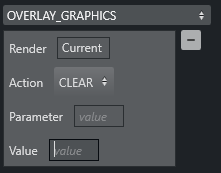
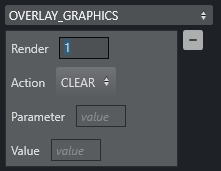
Parameter field value has a higher precedence than the value of Render.
-
Value field is ignored.
-
-
CONTINUE: If the current overlay graphics contains stop points/triggers, this command continues the timeline.
The Parameter can be either one of the Mosart graphics destinations (channels) or a valid graphics ID.
If the Parameter-field is not empty, and the value given is not found among the destinations configured in the Viz Mosart OverlayGraphics, then this is considered to be a graphics ID.
In such cases, the destination is searched for in the configured destinations from within the OverlayGraphics settings based on the value of the Render-field (which is the engine ID).
Possible values for the Value-field:-
STRICT: means that the shortcut is executed only if the graphics contain continue points.
-
<empty>: Applies to all the graphics.
Default: Send a Continue with SHIFT+F11
-
-
PRETAKE NEXT: With this command, the next overlay graphics in the timeline are taken in.
Parameter field can contain a graphics Handler name (WALL or DSK etc). This value overrides the value in Render.
Default: CTRL + O. -
TAKE LAST OUT: This command takes out the last overlay graphics which have been taken in. Render value has no effect.
In the Parameter field, it is possible to enter a graphics Handler name (WALL or DSK etc.). Default: HOME. -
TAKE MANUAL OUT: This command takes out overlay graphics which have been set to wait for a manual take out.
Parameter field specifies the name of the destination to take out the graphics from.
Default: SHIFT + HOME. -
TAKE NAMED OVERLAY: This command is to take a specific named overlay graphic item to air via a keyboard shortcut.
Parameter field holds ItemId. If blank, use current item.
Value=Slug. -
MACRO : For graphics systems that support macro recall, this recalls a macro on the defined engine(s).
Parameter field is the name of the macro to execute.For VIZRT graphics, two special macros are available: "INITIALIZE" (or "INITIALISE") and "CLEANUP", which initializes and clears the playlist, respectively.
SET_AUX_CROSSPOINT
Sets a crosspoint on one of the AUX buses on the mixer.
PARAMETERS: Select bus and specify crosspoint.
SET_CROSSPOINT
Sets a crosspoint on the vision mixer.
PARAMETERS: The operator can choose the ME, bus (A, B, C, D or keyers) and crosspoint for the command.
Buses C and D are used for video switchers supporting M/Es effects with 4 layers (e.g. vizrt-ips).
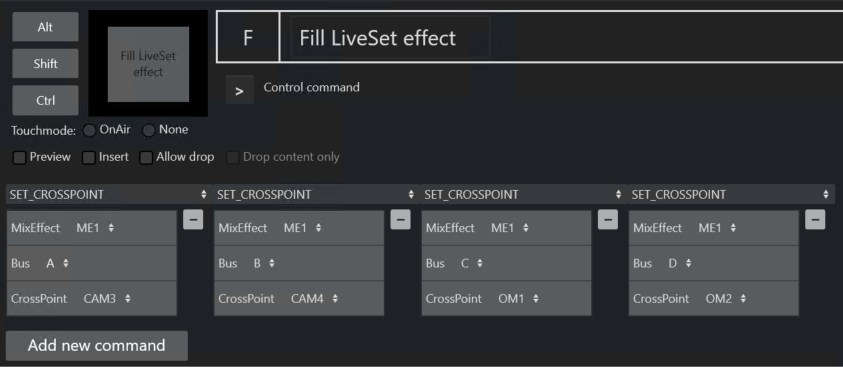
SET_CURRENT_ME
Sets a given ME On Air.
PARAMETERS: Choose an ME.
RUNDOWN_NCS_RESYNC
Initializes a reconnect to the NCS.
SEQUENCE
Contains controls for a sequence as defined in a template.
This applies to all secondary items; including lowerthird graphics and accessories.
In a rundown in the GUI, you can right-click on a story → Edit → Save story as sequence.
-
START: Restarts a previously stopped sequence.
-
STOP: Stops a running sequence.
-
STARTLOOP: Sets a running sequence to start looping.
-
STOPLOOP: Stops running a looped sequence in loop
STUDIOSETUP
Changes the current studio setup (template set) loaded.
PARAMETERS: Enter the name of the desired studio setup.
VIDEOWALLMODE
Toggles a mode where key parts of production are shifted via an ME to a connected video wall (e.g. video server ripple, but not camera switching). It is not recommended to use this feature without consulting Viz Mosart support.
PARAMETERS: The ME to be used.
TAKE_SERVER_TO_PROGRAM
Takes a video server port to program on a selected ME. For example: a video clip is running on a video wall. The shortcut can then be used to take the last used/active video server to program.
PARAMETERS: Select on which ME the video server should be taken to program, and the transition rate to use.
TRANSITION_TYPE
Sets the transition type to use on the next transition.
PARAMETERS
TransitionType: The type can be set including Toggle (default), which cycles through the various transition types. In the Value field, the transition rate in frames can be set, or the effect number for the mixer effect transition type.
Value: Used to set a specific value for the TYPE.
|
Transition Type |
Value |
Description |
|
TOGGLE_SELECT |
|
Toggle between MIX,WIPE,EFFECT |
|
CUT |
|
Set the transition to be mix with value = 0 |
|
MIX |
|
Set the transition to be mix with the specified value as number of frames |
|
WIPE |
|
Set the transition to be wipe with the specified value as number of frames |
|
EFFECT |
|
Set the transition to be effect with the effect number specified in the value field |
WEATHER
Controls the timeline of a connected Viz Weather system.
-
PLAY: This command starts the timeline of the weather system.
-
CONTINUE: When a weather timeline has stop points, this command sends continue commands to the timeline.
-
GO TO FIRST: This command cues the weather scene to its first page/frame.
ACCESSORIES
Pretakes an accessory. Pretake requires the accessory template to have preload enabled and also a primary type to trigger the pretake defined. Only use accessories with in-time=0.
SET_VIDEOSERVER_SALVO
Switches to the videoserver salvo specified in the combobox parameter.
NCS
This control command is for the OpenMedia newsroom system specifically.
Action:
START_STATUS,
STOP_STATUS
Parameter:
RUNDOWN
STORY
ITEM
SWITCH_VIDEOSERVER_MIRRORING
Toggles a switch of any mirrored video ports.
SWITCH_GRAPHICS_MIRRORING
TOGGLE - Toggles mirroring mode for graphics for fullscreen graphics.
ACTIVATE - Activates mirroring mode.
DEACTIVATE - Deactivates mirroring.
RECORD

The Record control command has the following parameters:
-
Command:
-
PREPARE: Cue a recording.
-
START: Starts a recording previously PREPAREd.
-
STOP: Stops a recording previously STARTed.
-
DELETE
-
-
ClipName (PREPARE only): The name of the clip to be created.
Note: It is possible to include the current gallery/studio, template set, and time in the name of the created clip. For details please refer to section Video Server, MAM and Database Connection Strings in the Viz Mosart Administrator Guide (ClipNamePattern property).
-
PortName (PREPARE only): The name of the video port where the recording shall take place. Note that this port has to be part of the “Rec” virtual video port group.
Default value is “Rec”.Note: For the setup of recording ports, please refer to section AV Automation Devices Video Servers in the Viz Mosart Administrator Guide.
-
Recorder: A user-defined name to be used for a recording, tied to ClipName and PortName. Set in the PREPARE command and subsequently used by the START and STOP commands. A value of Default selects the default recorder.
QUICKEVENT
Quickevent control command has the following commands:
|
Name |
Description |
|
TOGGLE_SELECT |
Viz Mosart marks the current item in the list as group-selected. The group selected items can be iterated with NEXT_GROUP_ITEM and PREVIOUS_GROUP_ITEM. |
|
NEXT_GROUP_ITEM |
Viz Mosart selects the next group-selected item (down). |
|
PREVIOUS_GROUP_ITEM |
Viz Mosart selects the previous pre-selected item (up). |
|
CLEAR_SELECTION |
All selected and group-selected marks are removed. |
|
NEXT_ITEM |
Viz Mosart selects the next item (down). |
|
PREVIOUS_ITEM |
Viz Mosart selects the previous item (up). |
|
TAKE_SELECTED |
Viz Mosart attempts to put the selected item to air. |
|
TAKE_SELECTED_TO_WALL |
Viz Mosart takes the selected item to the wall item specified in the parameter. See Template Router . |
|
PREVIEW_SELECTED |
Viz Mosart attempts to put the current selected item to preview. |
|
PREVIEW_SELECTED_TO_WALL |
Viz Mosart puts the selected item to the selected wall salvo preview wall item specified in the parameter. See Template Router. |
|
PRELOAD_SELECTED |
Viz Mosart tries to preload the current selected item to the preload port\engine if available and configured in AvAutomation. |
|
FILTER_LEFT |
Viz Mosart switches the selected filter to the filter displayed to the left of the currently selected filter (this also works with QAP). |
|
FILTER_RIGHT |
Viz Mosart switches the selected filter to the filter displayed to the right of the currently selected filter (this also works with QAP). |
|
LOWERTHIRD_ACTION_SELECTED |
Viz Mosart puts the selected lowerthird in the quick access tab based on the parameter.
|
VIDEO_PORT

Command for sending a specific command directly to a specific video port. Not applicable for all video servers, behavior varies depending on video server type.
Is not visible in the rundown (only visible in Template Router)!
Action: What action to perform on clip assigned to port:
-
PLAY_PAUSE: Play or Pause assigned clip
-
STOP: Stop assigned clip
-
CUE: Cue assigned clip
-
RECUE: ReCue assigned clip
-
SET_LOOP: Tells the video player to loop the current clip
-
PLAY_TAIL: Skip to end of clip and start playing. Use parameter e.g. -10 to skip to 10 seconds before end of clip. Used for rehearsal.
-
CUE_TAIL: Same as PLAY_TAIL but does not start to play.
VideoPort: Name of the video port for sending commands to.
Parameter: Used for PLAY_TAIL and CUE_TAIL commands. Specified length from end or start of clip to skip to. Use negative number to count from end.
DEVICE_PROPERTY
n/a
USER_MESSAGE
When the keyboard shortcut is activated it adds a user_message log message to all connected logs with the message configured in the keyboard shortcut.
User can insert a simple log message to appear when the button is pressed. This is useful for the operator in fault-finding situations, where, a known message string can be pushed into the log, for example, at the point of a troublesome situation in a production.
OVERLAY_TO_MANUAL
Converts all lowerthirds(overlays) to manual for the current, preview or selected story.
The control command OVERLAY_TO_MANUAL has three optional parameters:
-
Parameter 1: The type of story to be converted, either:
-
SELECTED (default): The selected story in the GUI.
-
PREVIEW: The next story
-
ONAIR: The on air story
-
-
Parameter 2: Comma-separated list of handler names, e.g. WALL,DSK. Empty list means all handlers.
-
Parameter 3: Method for the converted overlays to be taken out, either:
-
AUTOMATIC (default)
-
MANUAL
When activated, OVERLAY_TO_MANUAL converts all lower-thirds in the specified story (Parameter 1) with the specified handler name (Parameter 2) to MANUAL. If no handler name is specified, it converts all lower-thirds in that story to MANUAL. If Parameter 3 is set to MANUAL, the converted overlays also have to be taken out manually, otherwise they are taken out (automatically) after the specified duration.
-
STORY_ACTION
Invokes an action on a target story. This can replace functionality in the story context menu by a shortcut. Can only be used from GUI.
The control command STORY_ACTION has two mandatory parameters:
-
Parameter 1 (Target): The type of story to be converted, either:
-
SELECTED (default): The selected story. Used for GUI.
-
PREVIEW: The next story
-
ONAIR: The on air story
-
-
Parameter 2 (Action):
Name
Description
SELECTED
PREVIEW
ONAIR
TOGGLE_COUNT_DOWN_TO
Toggle the target story count down to the target story
SET_AS_NEXT
Set the target story as next
SET_AS_NEXT_AND_SKIP
Set the target story as next and skip any remaining items
TOGGLE_LOCK
Toggle the lock story from NCS update on the target story
REMOVE
Remove the target story
LOOP_START
Set the start loop at the target story
LOOP_END
Set the end loop at the target story
LOOP_CLEAR
Clears any loops in the rundown
APPEND_ITEMS_TO_CURRENT
Take all items of target story and append them after the current on air item
Additional Control Command Actions
In addition to being assigned to shortcut keys, control commands can be:
-
Set into the Viz Mosart timeline (from the NCS), using written commands. For example, using a textual command, either as a machine command in iNews or like this in ENPS.
This command performs a DVE FORWARD four seconds into the main item:(**COMMAND=DVE FORWARD <00:04**) -
Attached to templates as continue points
-
Attached to templates to be automatically performed when a template goes on-air or off-air
-
Used for changing the template set
-
Used for changing the graphics profile
-
Used for setting the system in AUTOTAKE-mode.
For further details of the control commands that can be attached to a template, please refer to the Viz Mosart Administrator Guide.
Parameters with Placeholders
Control command parameters may contain placeholders which can be replaced with values found in the fields of the Viz Mosart item which is currently on-air. Refer to the Viz Mosart Administrator Guide, section Parameters with placeholders, in Additional Template Functionality.